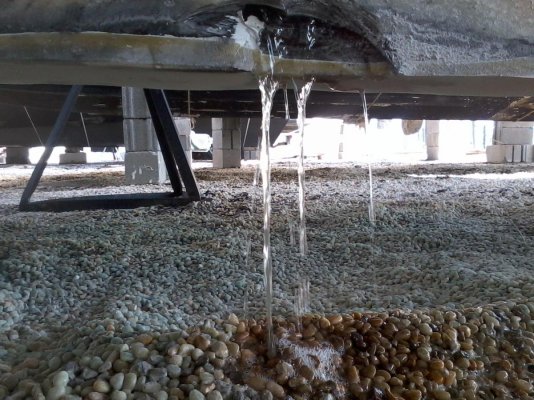Jbear
Senior Member
Hello all,
New to Trawlers but not boats. I was in the bilge cleaning and hanging cables, etc. last night and noticed there was a very small amount of water "seeping" through the hull. I had dried everything to make it possible to access the parts I wanted to work on. Upon further inspection I found that the water was coming through what appears to be FG over the keel section.
In doing some research I found that some of these TT had stern tubes that would leak. Is there a way to determine if I have a leak in the stern tube that is filling up the keel and leaching into the bilge or if the "normal" water from my packing has leached downward and filled up my keel.
It seems to me that any boat that has had water sitting in the bilge for 44 years would have water going into the keel. My real concern is that I was installing a very small bilge pump to keep this water level down below my (2) 1100GPH main pumps and when I put the screw in water was actually coming up. No, I did not pierce the hull as this is very near center of the boat and on the "flat" portion over top of the keel.
The rudder post/box is not leaking at all. The shaft (drive) stuffing box drips as it should 2-3 per minute. There was indication that water may have been higher in the bilge at one time but the last time I dried the hull when I was scrubbing it out about 1 gallon of water came back in after 12 days or so. I did drive the boat during that 10 day period for about 30 minutes.
I appreciate any thoughts on this. I knew I would have the typical issues with ports and teak decks but this was new, and very concerning to me. I did a tapping test of the hull and it seems very sound. I do believe there is foam, cement, or a void in the keel that is full of water though and I want that fixed.
Thanks,
Jeff
Boat: 35' Eagle Tri-Cabin built by Shin Hsing.
1977 13.6 Beam (a major reason for the purchase- lots of room in a 35')
120 HP Lehman 3.5Kw Yanmar
1.5" Stainless Shaft in typical bronze boxes with bronze cutlass bearings.
New to Trawlers but not boats. I was in the bilge cleaning and hanging cables, etc. last night and noticed there was a very small amount of water "seeping" through the hull. I had dried everything to make it possible to access the parts I wanted to work on. Upon further inspection I found that the water was coming through what appears to be FG over the keel section.
In doing some research I found that some of these TT had stern tubes that would leak. Is there a way to determine if I have a leak in the stern tube that is filling up the keel and leaching into the bilge or if the "normal" water from my packing has leached downward and filled up my keel.
It seems to me that any boat that has had water sitting in the bilge for 44 years would have water going into the keel. My real concern is that I was installing a very small bilge pump to keep this water level down below my (2) 1100GPH main pumps and when I put the screw in water was actually coming up. No, I did not pierce the hull as this is very near center of the boat and on the "flat" portion over top of the keel.
The rudder post/box is not leaking at all. The shaft (drive) stuffing box drips as it should 2-3 per minute. There was indication that water may have been higher in the bilge at one time but the last time I dried the hull when I was scrubbing it out about 1 gallon of water came back in after 12 days or so. I did drive the boat during that 10 day period for about 30 minutes.
I appreciate any thoughts on this. I knew I would have the typical issues with ports and teak decks but this was new, and very concerning to me. I did a tapping test of the hull and it seems very sound. I do believe there is foam, cement, or a void in the keel that is full of water though and I want that fixed.
Thanks,
Jeff
Boat: 35' Eagle Tri-Cabin built by Shin Hsing.
1977 13.6 Beam (a major reason for the purchase- lots of room in a 35')
120 HP Lehman 3.5Kw Yanmar
1.5" Stainless Shaft in typical bronze boxes with bronze cutlass bearings.



